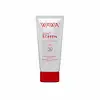What's inside
What's inside
 Key Ingredients
Key Ingredients

 Benefits
Benefits

 Concerns
Concerns

 Ingredients Side-by-side
Ingredients Side-by-side

Aloe Barbadensis Leaf Water
MaskingHomosalate
Skin ConditioningButylene Glycol
HumectantDiethylamino Hydroxybenzoyl Hexyl Benzoate
UV FilterEthylhexyl Salicylate
UV AbsorberGlycerin
HumectantWater
Skin ConditioningBis-Ethylhexyloxyphenol Methoxyphenyl Triazine
Skin ConditioningC12-15 Alkyl Benzoate
AntimicrobialMethyl Trimethicone
Skin ConditioningNiacinamide
SmoothingCI 77891
Cosmetic ColorantDiisopropyl Sebacate
EmollientTerephthalylidene Dicamphor Sulfonic Acid
UV Absorber1,2-Hexanediol
Skin ConditioningPotassium Cetyl Phosphate
EmulsifyingCetearyl Alcohol
EmollientTromethamine
BufferingGlyceryl Stearate
EmollientBehenyl Alcohol
EmollientPolyacrylate Crosspolymer-6
Emulsion StabilisingXanthan Gum
EmulsifyingSodium Polyacryloyldimethyl Taurate
Emulsion StabilisingHydrogenated Lecithin
EmulsifyingPoly C10-30 Alkyl Acrylate
Emulsion StabilisingEthylhexylglycerin
Skin ConditioningStearic Acid
CleansingAluminum Hydroxide
EmollientPolyglyceryl-3 Methylglucose Distearate
EmulsifyingPalmitic Acid
EmollientCI 77491
Cosmetic ColorantDisodium EDTA
Triethoxycaprylylsilane
CI 77492
Cosmetic ColorantSodium Hyaluronate
HumectantAllantoin
Skin ConditioningMyristic Acid
CleansingCyanocobalamin
Skin ConditioningLauric Acid
CleansingTocopherol
AntioxidantAloe Barbadensis Leaf Water, Homosalate, Butylene Glycol, Diethylamino Hydroxybenzoyl Hexyl Benzoate, Ethylhexyl Salicylate, Glycerin, Water, Bis-Ethylhexyloxyphenol Methoxyphenyl Triazine, C12-15 Alkyl Benzoate, Methyl Trimethicone, Niacinamide, CI 77891, Diisopropyl Sebacate, Terephthalylidene Dicamphor Sulfonic Acid, 1,2-Hexanediol, Potassium Cetyl Phosphate, Cetearyl Alcohol, Tromethamine, Glyceryl Stearate, Behenyl Alcohol, Polyacrylate Crosspolymer-6, Xanthan Gum, Sodium Polyacryloyldimethyl Taurate, Hydrogenated Lecithin, Poly C10-30 Alkyl Acrylate, Ethylhexylglycerin, Stearic Acid, Aluminum Hydroxide, Polyglyceryl-3 Methylglucose Distearate, Palmitic Acid, CI 77491, Disodium EDTA, Triethoxycaprylylsilane, CI 77492, Sodium Hyaluronate, Allantoin, Myristic Acid, Cyanocobalamin, Lauric Acid, Tocopherol
Water
Skin ConditioningEthylhexyl Methoxycinnamate
UV AbsorberSqualane
EmollientGlycerin
HumectantTitanium Dioxide
Cosmetic ColorantAscorbyl Methylsilanol Pectinate
AntioxidantPolyacrylamide
C13-14 Isoparaffin
EmollientC9-11 Pareth-6
EmulsifyingOctyldodecyl Oleate
EmollientArgania Spinosa Kernel Oil
EmollientAlcohol
AntimicrobialLecithin
EmollientArbutin
AntioxidantLinolenic Acid
CleansingLinoleic Acid
CleansingTocopheryl Acetate
AntioxidantAscorbyl Palmitate
AntioxidantGlutathione
Aloe Barbadensis Extract
Skin ConditioningSodium Hyaluronate
HumectantAllantoin
Skin ConditioningPanthenol
Skin ConditioningPhenoxyethanol
PreservativeChlorphenesin
AntimicrobialParfum
MaskingWater, Ethylhexyl Methoxycinnamate, Squalane, Glycerin, Titanium Dioxide, Ascorbyl Methylsilanol Pectinate, Polyacrylamide, C13-14 Isoparaffin, C9-11 Pareth-6, Octyldodecyl Oleate, Argania Spinosa Kernel Oil, Alcohol, Lecithin, Arbutin, Linolenic Acid, Linoleic Acid, Tocopheryl Acetate, Ascorbyl Palmitate, Glutathione, Aloe Barbadensis Extract, Sodium Hyaluronate, Allantoin, Panthenol, Phenoxyethanol, Chlorphenesin, Parfum
 Reviews
Reviews

Ingredients Explained
These ingredients are found in both products.
Ingredients higher up in an ingredient list are typically present in a larger amount.
Allantoin is a soothing ingredient known for its protective and moisturizingg properties. Because of this, it is often added to products with strong active ingredients.
Studies show higher concentrations of this ingredient can promote wound healing.
Though it can be derived from the comfrey plant, allantoin is produced synthetically for cosmetic products to ensure purity.
Learn more about AllantoinGlycerin is already naturally found in your skin. It helps moisturize and protect your skin.
A study from 2016 found glycerin to be more effective as a humectant than AHAs and hyaluronic acid.
As a humectant, it helps the skin stay hydrated by pulling moisture to your skin. The low molecular weight of glycerin allows it to pull moisture into the deeper layers of your skin.
Hydrated skin improves your skin barrier; Your skin barrier helps protect against irritants and bacteria.
Glycerin has also been found to have antimicrobial and antiviral properties. Due to these properties, glycerin is often used in wound and burn treatments.
In cosmetics, glycerin is usually derived from plants such as soybean or palm. However, it can also be sourced from animals, such as tallow or animal fat.
This ingredient is organic, colorless, odorless, and non-toxic.
Glycerin is the name for this ingredient in American English. British English uses Glycerol/Glycerine.
Learn more about GlycerinSodium Hyaluronate is hyaluronic acid's salt form. It is commonly derived from the sodium salt of hyaluronic acid.
Like hyaluronic acid, it is great at holding water and acts as a humectant. This makes it a great skin hydrating ingredient.
Sodium Hyaluronate is naturally occurring in our bodies and is mostly found in eye fluid and joints.
These are some other common types of Hyaluronic Acid:
Learn more about Sodium HyaluronateWater. It's the most common cosmetic ingredient of all. You'll usually see it at the top of ingredient lists, meaning that it makes up the largest part of the product.
So why is it so popular? Water most often acts as a solvent - this means that it helps dissolve other ingredients into the formulation.
You'll also recognize water as that liquid we all need to stay alive. If you see this, drink a glass of water. Stay hydrated!
Learn more about Water